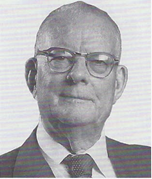Production systems and their founding fathers: William Edwards Deming (1900 – 1993)
Deming grew up at the farm of his grandfather in Polk City. In 1917, he attended the University of Wyoming. In 1921, he received a Bachelor of science in electrical engineering. In 1925, he received a master’s degree at the University of Colorado. In 1928, he earned his doctorate at Yale University.
For a few years he studied with Walter a. Shewhart of Bell Telephone Laboratories. Shewhart’s theories about statistical control were the basis for Deming’s work. Statistical process control. This technique was applied massively times during the second world war, but faded in a few years.
Deming is known through his lectures in Japan. The first time he
statistics and his vision about quality and quality management. Deming left behind so much impression with his speeches and lectures, that the Japanese Union for scientists and engineers (JUSE) asked him to return to Japan.
The members of JUSE studied Shewhart’s techniques, and as part of Japan’s reconstruction efforts, they sought an expert to teach statistical control. In 1950, Deming gave a dozen lectures about statistical quality control (SQC) for the first time. Contrary to his previous lectures, this time he addressed himself to the Japanese chief executives: improvement of quality will lead to a reduction of expenses and a raise in productivity and market share.
Ishikawa Kaoru, who developed more quality tools in addition to the well-known Ishikawa diagram, allowed Deming to present his findings to the Japanese top managers in 1950. Hereafter, from 1950 to 1980, Deming spent more time in Japan than in the United States. The Japanese characterize Deming as father of the quality movement in their country. He has contributed significantly to Japan’s economic recovery after the war. For this he was awarded the star of the Grand Officer of the order of the sacred treasure in 1960 as the first American by the former Prime Minister Nobusuke Kishi
Only since Japan could guarantee high-quality products on the market at the end of the 1970th, became clear, for what was a secret of the Japanese success, that the American Deming was the “brain” behind the Japanese quality. In response to this awareness, all American institutions has been urged to start an extensive quality campaign. The official initiator of this action was the television network NBC. The slogan was: “If Japan can, why can’t we?”.
This was a turning point for Edwards Deming in the United States. Since then he conquered not only the United States by his teachings, but the entire world. Deming gained world fame and receive several honours has been given to him. Edwards Deming reached one of the most popular approaches to the understanding of quality, through the spread of the so-called Shewhart’s cycle (known as the circle/PDCA (Plan-Do-Check-Act)). He did so well that this henceforth unambiguous is referred to as Deming’s PDCA circle.
Deming’s 14 steps for better management
- Create a constant goal towards improvement of product and service, in order to stay competitive in business and employment.
- Adopt the new philosophy which can guarantee economic stability. We are in a new economic age. Western management must take the lead and learn their responsibilities in context of change.
- End dependence of mass inspections. Eliminate the need for inspections by building in quality into the product in the first place. To reduce costs
- Stop giving assignments on the basis of price tags. Instead, minimize total costs. Move towards one single supplier for every single one item, on basis of a long-term relationship of loyalty and trust.
- Improve constantly and for forever the system of production and service, to improve quality and productivity, and thus constantly decrease costs.
- Institute trainings on the job. For all levels
- Adopt and install leadership. The goal must not be supervision, but helping people and machines and gadgets to do a better job.
- Drive out fear, so that everyone may work effectively for the company.
- Break down barriers between departments. People in research, design, sales, and production must work as a team, to foresee problems in the production and use, that may be encountered with the product or service.
- Eliminate slogans, warnings and targets for the employees. Problems with quality and productivity are caused by the system, not by individuals.
- Eliminate numeric quotes for employees and numeric goals for people in the management.
- Remove barriers that rob people of their right to pride of workmanship. This means, for example, abolishment of the yearly performance evaluations.
- Encourage education and self-improvement for everyone.
- Take action to reach the transformation. Commitment of everyone is required.
Literature
Deming, W. E.: Out of the crisis. Massachusetts: Massachusetts Institute of Technology, 1982
Klein Nagelvoort, Drs. R.M., Organisatie en management, 1975
Neuhaus, Prof. Dr. Ralf (Institut für angewandte Arbeitswissenschaft (ifaA), 2011
Wikipedia
www.archive.org
www.deming.org
Out of the Crisis, MIT-Press, ISBN 0-262-54115-7

